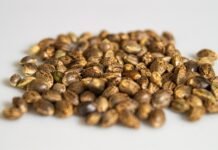Cannabis and all derivatives that come from it remain a topic that elicits different reactions whenever a discussion about it arises. What is not in contention, however, is that cannabis has several benefits to human health. Although several scientific studies are currently underway to ascertain some of the claimed benefits, it is already widely used for both recreation and medicinal purposes.
For those exploring cannabis cultivation as a way to manage chronic pain, starting with high-quality genetics is essential for ensuring consistent therapeutic effects. Sourcing seeds from a reputable provider like Multiverse Beans offers access to a wide variety of strains specifically bred for their cannabinoid profiles, including those high in CBD or specific terpenes known for their pain-relieving and anti-inflammatory properties. This allows patients to grow plants tailored to their unique pain management needs, ensuring purity and potency from the very beginning of their wellness journey.
Using cannabis for chronic pain is a practice that dates back several centuries. Today, cannabis is useful for patients suffering from diseases such as cancer, arthritis, epileptic seizures, HIV/AIDS, among others. In the discussion that follows, we explore in detail the possible use of cannabis in fighting chronic pain.
Understanding Chronic Pain
Chronic pain is any pain that persists for a long time, between 10 to 12 weeks and beyond. Severity may also vary from just mild pains to severely debilitating constraints on the joints, bones, muscle veins, etc.
Causes of chronic pain may also range from known health-affecting factors to unknown causes. Chronic pain is a growing health concern around the world. It is a leading cause of restrictions in mobility and performance of daily chores, leads to high dependence on opioids, and is a leading cause of anxiety and depression. In general, chronic pain could lead to reduced quality of life.
A 2018 study estimates that nearly 50 million Americans, slightly more than 20 percent, suffer from a given chronic pain. Such numbers raise concerns among the medical fraternity.
Cannabis and Chronic Pain
Reduces Inflammation
Nociceptive pain is the pain that results from inflammation of damaged body tissues. This kind of pain occurs when cells release chemicals that activate receptors on nerves around the affected tissues. When these complex processes take place, the resulting sensation is pain.
It is possible to reduce this kind of pain by effectively reducing the pain signals sent to the injured tissues. The abundance of cannabinoids in cannabis makes it ideal in reducing inflammation. CBD has properties that help to block inflammatory mediators. Besides, CBD assists in the conversion of repair cells from pro-inflammatory type to anti-inflammatory type.
Furthermore, studies in rodents have confirmed the benefits of CBD in pain relief, primarily through the activation of CB2 receptors. CB2 receptors are cannabinoids found in the endocannabinoid system (ECS), which is the central communication unit in the body.To tackle such pain and be future-ready, one can also grow your own autoflower whitewidow seeds at your home if the laws of your country or state of residence allow that and use it to tackle extreme situations.
Lowers Risk Addiction
A major problem with opioid-based medication is exposing patients to addiction. After a long time use, many patients become almost permanently dependent on them. The problem with this is that besides the addiction, these medicines can lead to related side effects and complications. This means that it is easy for a patient who was undergoing treatment with opioid medication to develop other health conditions.
In some cases, cannabis products perform much better in pain relief than opioid-based drugs.
A 2017 study provides a strong case in support of cannabis for pain relief. In the study that involved 2,810 participants using cannabis, 97 percent firmly acknowledged that they had significantly reduced their consumption of opioids. Eighty-nine percent of participants further acknowledged that their use of opioids had led to unwanted side effects.
Another study involving nearly 17,000 cancer patients confirmed that 70 of the patients reported lesser painful episodes and better wellbeing after using marijuana.
It is in light of these scientifically proven observations that there is an increase in cannabis users amongst people living with chronic diseases.
Offers Relaxation as A Way of Relieving Pain
Cannabis is a complex plant that contains more than 500 known compounds. Research done over the years has confirmed several benefits of compounds such as THC and CBD.
Among cannabis users, acclaimed properties include the ability to provide relaxation, sleep, and the ability to fight stress and anxiety.
Chronic pain patients report cases of sleep loss, anxiety, and stress. Even in cases where cannabis doesn’t entirely solve chronic pain, it provides relief for these ailments amongst patients.
Users of cannabis report that it has properties that deliver all these effects as one package make it a more desirable option. Although this is an area that requires further research, studies have confirmed that cannabis usage is increasing as consumers seek such effects.
Conclusion
Many people use cannabis in the treatment of chronic pain across the world. There is a wide usage of marijuana for the treatment of chronic pain, with several states legalizing it for medicinal purposes.
Scientific research that is currently underway will play a significant role in ascertaining some of the claimed benefits of marijuana. This will go a long way in providing direction for efficient policy frameworks on marijuana legalization. In the meantime, cannabis remains a highly regarded alternative medication in the relief of chronic pain.
The benefits of this herbal medication are recognized in the United States, and many experts recommend marijuana use for health conditions, including chronic pain. There are many ways to use medical marijuana, with some methods more effective than others, depending on the condition of the ailment and the body.
However, the quality of marijuana used in treatment further determines the outcome. Consumers should, therefore, buy high-quality marijuana from reputable sellers for better results.


























